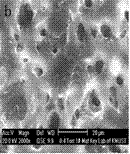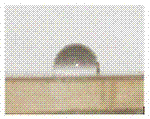ABS resin material with self-cleaned surface and preparation method thereof
An ABS resin, self-cleaning technology, applied in the field of functional materials, to achieve the effect of improving mechanical properties, eliminating the trouble of cleaning and saving energy
- Summary
- Abstract
- Description
- Claims
- Application Information
AI Technical Summary
Problems solved by technology
Method used
Image
Examples
Embodiment 1
[0025] Preparation of hydrophobic ABS by template method:
[0026] Feed according to the following formula:
[0027] ABS resin pellets 9.5g
[0028] Micron aluminum powder 4 grams
[0029] Nano aluminum powder 1g
[0030] By the following method:
[0031] (1) Mix the above-mentioned ABS particles with micro- and nano-aluminum powders evenly, heat them in a mosaic machine at 100°C for 30 minutes, and then heat-press them at 180°C to obtain ABS-Al plates;
[0032] (2) Soak the ABS-Al plate in step (1) in dilute hydrochloric acid with a mass concentration of 20% for 2 minutes to dissolve the Al on the surface, and obtain an ABS-Al plate with hydrophobic properties, which is resistant to water The contact angle was 117°.
Embodiment 2
[0034] Preparation of hydrophobic ABS by template method:
[0035] Feed according to the following formula:
[0036] ABS resin pellets 99.9g
[0037] Micron aluminum powder 0.08g
[0038] Nano aluminum powder 0.02g
[0039] By the following method:
[0040] (1) Take the above-mentioned ABS particles and heat them directly in the mounting machine at 140°C for 10 minutes, and then heat-press them at 150°C to obtain ABS boards;
[0041] (2) Immediately paint a layer of micron aluminum powder and nano-aluminum powder on the surface of the ABS board in step (1), and then press it in a mounting machine at 160°C to obtain an ABS-Al board;
[0042] (3) Soak the ABS-Al plate obtained in step (2) in dilute hydrochloric acid with a mass concentration of 5% for 120 minutes, and dissolve the Al powder on the surface, and obtain an ABS-Al plate with hydrophobic properties. At this time, the ABS plate The contact angle to water is 121°.
Embodiment 3
[0044] Preparation of hydrophobic ABS by template method:
[0045] Feed according to the following formula:
[0046] ABS resin pellets 8.8g
[0047] Micron aluminum powder 0.9g
[0048] Nano aluminum powder 0.3g
[0049] By the following method:
[0050] (1) Take the above-mentioned ABS particles and mix them evenly with micro- and nano-aluminum powders, heat them in a mosaic machine at 120°C for 20 minutes, and then heat-press them at 170°C to obtain ABS-Al plates;
[0051] (2) Soak the ABS-Al plate in step (1) in dilute hydrochloric acid with a mass concentration of 10% for 60 minutes to dissolve the Al on the surface, and obtain an ABS-Al plate with hydrophobic properties, which is resistant to water The contact angle was 119°.
PUM
 Login to View More
Login to View More Abstract
Description
Claims
Application Information
 Login to View More
Login to View More - R&D
- Intellectual Property
- Life Sciences
- Materials
- Tech Scout
- Unparalleled Data Quality
- Higher Quality Content
- 60% Fewer Hallucinations
Browse by: Latest US Patents, China's latest patents, Technical Efficacy Thesaurus, Application Domain, Technology Topic, Popular Technical Reports.
© 2025 PatSnap. All rights reserved.Legal|Privacy policy|Modern Slavery Act Transparency Statement|Sitemap|About US| Contact US: help@patsnap.com


